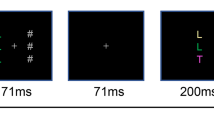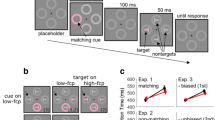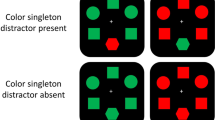Abstract
To investigate whether attentional suppression is merely a byproduct of target facilitation or a result of independent mechanisms for distractor suppression, the present study examined whether attentional suppression takes place when target facilitation hardly occurs using a spatial cueing paradigm. Participants searched for target letters that were not red, i.e., a negative color. On each trial, a target color was randomly chosen among 12 colors to prevent establishing attentional control for target colors and to reduce intertrial priming for target colors. Immediately before a target display, a noninformative spatial cue was presented at one of the possible target locations. The cue was rendered in a negative color, which was to be ignored, to detect targets or the reference color, which was never presented for target and non-target letters. Experiment 1 showed that negative color cues captured attention less than reference color cues, suggesting feature-based attentional suppression. The suppression effect was replicated when the temporal interval between the onsets of the cue and target displays was reduced in Experiments 2 and 3, suggesting proactive suppression. Experiment 3 directly confirmed no attentional control settings for target colors and intertrial priming. These findings suggest that distractor features can guide attention at the pre-attentive stage when target features are not used to attend to targets.








Similar content being viewed by others
Data availability
The data from the experiments are available at https://osf.io/dn2va.
References
Anderson, B. A., & Folk, C. L. (2010). Variations in the magnitude of attentional capture: Testing a two-process model. Attention, Perception, & Psychophysics, 72(2), 342–352.
Ansorge, U., & Heumann, M. (2003). Top-down contingencies in peripheral cuing: The roles of color and location. Journal of Experimental Psychology: Human Perception and Performance, 29(5), 937–948.
Awh, E., Belopolsky, A. V., & Theeuwes, J. (2012). Top-down versus bottom-up attentional control: A failed theoretical dichotomy. Trends in Cognitive Sciences, 16(8), 437–443.
Beck, M. R., Martin, B. A., Smitherman, E., & Gaschen, L. (2013). Eyes-on training and radiological expertise: An examination of expertise development and its effects on visual working memory. Human Factors, 55(4), 747–763.
Becker, S. I., Ansorge, U., & Horstmann, G. (2009). Can intertrial priming account for the similarity effect in visual search? Vision Research, 49(14), 1738–1756.
Belopolsky, A. V., Schreij, D., & Theeuwes, J. (2010). What is top-down about contingent capture? Attention, Perception, & Psychophysics, 72(2), 326–341.
Brascamp, J. W., Pels, E., & Kristjánsson, Á. (2011). Priming of pop-out on multiple time scales during visual search. Vision Research, 51(17), 1972–1978.
Braver, T. S., Gray, J. R., & Burgess, G. C. (2007). Explaining the many varieties of working memory variation: Dual mechanisms of cognitive control. In A. R. A. Conway, C. Jarrold, M. J. Kane, A. Miyake, & J. N. Towse (Eds.), Variation in working memory (pp. 76–106). Oxford University Press.
Braver, T. S., Kizhner, A., Tang, R., Freund, M. C., & Etzel, J. A. (2021). The dual mechanisms of cognitive control project. Journal of Cognitive Neuroscience, 33(9), 1990–2015.
Chelazzi, L., Marini, F., Pascucci, D., & Turatto, M. (2019). Getting rid of visual distractors: The why, when, how, and where. Current Opinion in Psychology, 29, 135–147.
Cho, Y. S., & Proctor, R. W. (2001). Effect of an initiating action on the up-right/down-left advantage for vertically arrayed stimuli and horizontally arrayed responses. Journal of Experimental Psychology: Human Perception and Performance, 27(2), 472–484.
Desimone, R., & Duncan, J. (1995). Neural mechanisms of selective visual attention. Annual Review of Neuroscience, 18(1), 193–222.
Egeth, H. E., & Yantis, S. (1997). Visual attention: Control, representation, and time course. Annual Review of Psychology, 48(1), 269–297.
Folk, C. L., Remington, R. W., & Johnston, J. C. (1992). Involuntary covert orienting is contingent on attentional control settings. Journal of Experimental Psychology: Human Perception and Performance, 18(4), 1030–1044.
Forstinger, M., & Ansorge, U. (2023). Evidence for top-down suppression of negative features in the target feature dimension. Cognition, 235, 105415.
Forstinger, M., Grüner, M., & Ansorge, U. (2022). Unseeing the white bear: Negative search criteria guide visual attention through top-down suppression. Journal of Experimental Psychology: Human Perception and Performance, 48(6), 613–638.
Gaspelin, N., Leonard, C. J., & Luck, S. J. (2015). Direct evidence for active suppression of salient-but-irrelevant sensory inputs. Psychological Science, 26(11), 1740–1750.
Gaspelin, N., Leonard, C. J., & Luck, S. J. (2017). Suppression of overt attentional capture by salient-but-irrelevant color singletons. Attention, Perception, & Psychophysics, 79(1), 45–62.
Gaspelin, N., & Luck, S. J. (2018). Distinguishing among potential mechanisms of singleton suppression. Journal of Experimental Psychology: Human Perception and Performance, 44(4), 626–644.
Geng, J. J., & Duarte, S. E. (2021). Unresolved issues in distractor suppression: Proactive and reactive mechanisms, implicit learning, and naturalistic distraction. Visual Cognition, 29(9), 608–613.
Hickey, C., Di Lollo, V., & McDonald, J. J. (2009). Electrophysiological indices of target and distractor processing in visual search. Journal of Cognitive Neuroscience, 21(4), 760–775.
Itti, L., Gold, C., & Koch, C. (2001). Visual attention and target detection in cluttered natural scenes. Optical Engineering, 40(9), 1784–1793.
Keele, S. W., & Neill, W. T. (1978). Mechanisms of attention. Perceptual Processing (pp. 3–47). Academic Press.
Kerzel, D., & Grubert, A. (2022). Capacity limitations in template-guided multiple color search. Psychonomic Bulletin & Review, 29(3), 901–909.
Kerzel, D., & Witzel, C. (2019). The allocation of resources in visual working memory and multiple attentional templates. Journal of Experimental Psychology: Human Perception and Performance, 45(5), 645–658.
Kerzel, D., & Huynh Cong, S. (2023). The PD reflects selection of nontarget locations, not distractor suppression. Journal of Cognitive Neuroscience, 35, 1478–1492.
Kim, S., & Cho, Y. S. (2016). Memory-based attentional capture by colour and shape contents in visual working memory. Visual Cognition, 24(1), 51–62.
Kim, S., & Beck, M. R. (2020). Non-spatial context-driven search. Attention, Perception, & Psychophysics, 82(6), 2876–2892.
Maljkovic, V., & Nakayama, K. (1994). Priming of pop-out: I. Role of features. Memory & Cognition, 22(6), 657–672.
Martini, P. (2010). System identification in priming of pop-out. Vision Research, 50(21), 2110–2115.
Moher, J., & Egeth, H. E. (2012). The ignoring paradox: Cueing distractor features leads first to selection, then to inhibition of to-be-ignored items. Attention, Perception, & Psychophysics, 74(8), 1590–1605.
Posner, M. I. (1980). Orienting of attention. Quarterly Journal of Experimental Psychology, 32(1), 3–25.
Proctor, R. W., & Cho, Y. S. (2006). Polarity correspondence: A general principle for performance of speeded binary classification tasks. Psychological Bulletin, 132(3), 416–442.
Sawaki, R., & Luck, S. J. (2010). Capture versus suppression of attention by salient singletons: Electrophysiological evidence for an automatic attend-to-me signal. Attention, Perception, & Psychophysics, 72(6), 1455–1470.
Schneider, D., Herbst, S. K., Klatt, L. I., & Wöstmann, M. (2022). Target enhancement or distractor suppression? Functionally distinct alpha oscillations form the basis of attention. European Journal of Neuroscience, 55(11–12), 3256–3265.
The MathWorks Inc. (2022). MATLAB version: 9.13.0 (R2022b), Natick, Massachusetts: The MathWorks Inc. https://www.mathworks.com
Theeuwes, J. (1992). Perceptual selectivity for color and form. Perception & Psychophysics, 51(6), 599–606.
Theeuwes, J. (2010). Top–down and bottom–up control of visual selection. Acta Psychologica, 135(2), 77–99.
Thornton, T. L., & Gilden, D. L. (2007). Parallel and serial processes in visual search. Psychological Review, 114(1), 71–103.
Tipper, S. P. (1985). The negative priming effect: Inhibitory priming by ignored objects. The Quarterly Journal of Experimental Psychology Section A, 37(4), 571–590.
Treisman, A. M., & Gelade, G. (1980). A feature-integration theory of attention. Cognitive Psychology, 12(1), 97–136.
van den Berg, R., Awh, E., & Ma, W. J. (2014). Factorial comparison of working memory models. Psychological Review, 121(1), 124–149.
van Moorselaar, D., & Slagter, H. A. (2020). Inhibition in selective attention. Annals of the New York Academy of Sciences, 1464(1), 204–221.
Vogel, E. K., & Machizawa, M. G. (2004). Neural activity predicts individual differences in visual working memory capacity. Nature, 428(6984), 748–751.
Wang, B., & Theeuwes, J. (2018). Statistical regularities modulate attentional capture. Journal of Experimental Psychology: Human Perception and Performance, 44(1), 13–17.
Ward, R., Duncan, J., & Shapiro, K. (1996). The slow time-course of visual attention. Cognitive Psychology, 30(1), 79–109.
Wolfe, J. M. (1994). Guided search 20.3: A revised model of visual search. Psychonomic Bulletin & Review, 1, 202–238.
Wolfe, J. M. (2021). Guided Search 6.0: An updated model of visual search. Psychonomic Bulletin & Review, 28(4), 1060–1092.
Won, B. Y., Kosoyan, M., & Geng, J. J. (2019). Evidence for second-order singleton suppression based on probabilistic expectations. Journal of Experimental Psychology: Human Perception and Performance, 45(1), 125–138.
Acknowledgements
This research was supported by a Basic Science Research Program through the National Research Foundation of Korea (NRF) funded by the Ministry of Education (NRF-2021R1I1A1A01055027, NRF-2020R1A2C2012033) and a Korea University Grant.
Author information
Authors and Affiliations
Corresponding author
Ethics declarations
Open practice statement
None of the experiments were preregistered.
Additional information
Publisher's Note
Springer Nature remains neutral with regard to jurisdictional claims in published maps and institutional affiliations.
The original online version of this article was revised: The sentence "Therefore, the presence of attentional suppression mechanisms is somewhat questionable" in the original article should be revised to read "Therefore, the presence of attentional suppression mechanisms is little questionable".
Rights and permissions
Springer Nature or its licensor (e.g. a society or other partner) holds exclusive rights to this article under a publishing agreement with the author(s) or other rightsholder(s); author self-archiving of the accepted manuscript version of this article is solely governed by the terms of such publishing agreement and applicable law.
About this article
Cite this article
Kim, S., Cho, Y.S. Feature-based attentional control for distractor suppression. Atten Percept Psychophys 86, 1075–1085 (2024). https://doi.org/10.3758/s13414-024-02858-x
Accepted:
Published:
Issue Date:
DOI: https://doi.org/10.3758/s13414-024-02858-x




